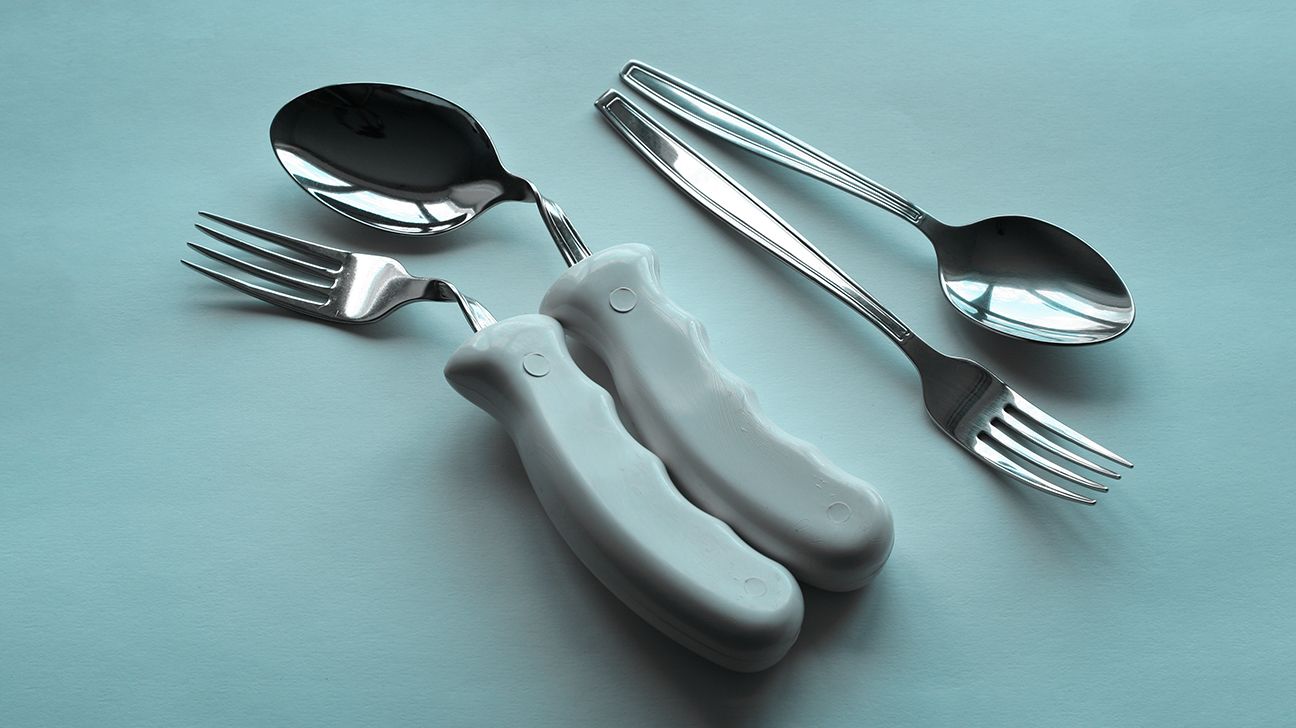
Parkinson’s disease symptoms like tremors, weakness, stiffness, and poor coordination can make it difficult or frustrating to eat. Adaptive utensils can help steady your hands and make it easier to grip your forks, spoons, and knives.
Over 1 million people in the United States are living with Parkinson’s disease, a progressive neurological disorder that causes problems with movement. The disease usually affects people after the age of 50 but sometimes can occur at a younger age.
The motor signs and symptoms of Parkinson’s disease include:
- tremors (shaking)
- stiffness or rigidity
- slowed movements
- dyskinesia (involuntary movements)
- poor coordination
- issues with balance
These symptoms can make cooking and eating more challenging and oftentimes frustrating.
If you have Parkinson’s disease, adaptations to eating utensils can help make mealtimes easier. But
Read on to learn about some of the adaptive utensils available to help people with Parkinson’s disease.
Stabilizing utensils are designed to address motor symptoms caused by Parkinson’s disease. If you have limited grip, weakness, tremor, stiffness, or rigidity, these utensils may help:
Utensils with weighted handles
Utensils with weighted handles look like other utensils, but they’re heavier. The added weight helps keep the utensil stable even if your hand is shaking due to tremor. Tremor is often the first motor symptom of Parkinson’s disease.
Wide-handled utensils
Utensils with a wide, built-up handle may be easier to hold if you have poor grip strength. The handles may also include a nonslip and ribbed design to improve grip.
Adaptable foam tubing for handles
You can also purchase foam padding tubes to attach to your existing utensils. The foam creates a wider, softer surface area that is nonslip. You can also use the foam around toothbrushes and pens.
Utensils that detect and counteract movement
Electronic “smart” utensils like the Liftware Steady and Liftware Level use sensors in the handle to detect hand motions. Once the computerized device recognizes a tremor, it uses a motor to stabilize the utensil and counteract the shaking.
These utensils are designed with stabilizing and leveling handles and attachments to help people with hand tremor or limited hand and arm mobility.
In a
Attachable handles and cuffs with straps
Attachable handles and cuffs with straps are great options if you’re experiencing muscle weakness, tremors, or poor grip strength. The forks and spoons include adjustable straps to bind the cutlery to your hand and prevent them from slipping.
Swiveling or bendable utensils with angle-changing handles or necks
These utensils include a swiveling or bending mechanism that helps keep your forks or spoons level during tremors. This can make eating less frustrating and prevent spills.
The bending or swiveling mechanism curves food toward your mouth, so you don’t have to lift your elbow as high while you eat. These options can be helpful if you have tremors or poor coordination.
Sloped plates and bowls
Sloped plates and bowls have built-in high rims that act as a wall to push against while you scoop food. They can help you guide food onto your eating utensils without spilling.
Plate guards
Like sloped bowls and plates, plate guards attach to the edge of regular bowls and dishes to support the scooping of food and minimize spilling.
Spill-prevention mugs and cups
If you have tremors, a weighted mug or cup can prevent spills. These mugs or cups typically have a large handle with a weighted base and a lid.
Cups and mugs with swivel handles for better grip
Cups and mugs with swivel handles help keep the cup level and steady. If the cup tilts, the cup self-stabilizes to give you more control. A swivel or rotatable handle can help if you have dexterity issues, poor grip strength, weakness, or tremor.
Nonslip mats
Nonslip mats, like Dycem mats, are made of a nonslip material that grips items like plates, bowls, or cutting boards to prevent them from moving around. These mats can be a great option if you have problems stabilizing kitchenware while preparing food.
Rocker knives
A rocker knife has a handle on the top and a rounded blade. This allows you to grasp and control the knife with one hand. They may be useful if you have difficulty with coordination or hand control. The see-saw motion created by the rounded blade also uses less energy than what you would use with a straight knife.
You’ll need to consider a few factors to determine which assistive eating utensils would be most useful for you. While cost, style, and materials are going to weigh into your decision, your symptoms and their severity are likely to play the biggest role in choosing which devices to try.
For example, if your biggest concern is weakness and grip strength, you may benefit most from utensils with a wider, ribbed handle. If you have tremors, you might wish to try weighted or swivel utensils.
If you’re not sure which utensils and assistive devices would benefit you the most, consider reaching out to an occupational therapist for advice and recommendations.
Adapted plates, bowls, and cups are also available. Most of these can be purchased online. An occupational therapist can provide recommendations based on your individual needs and preferences.
